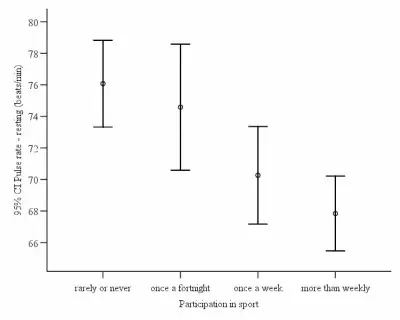Confidence intervals are an important concept in statistics. They help us to make estimates by using the data we have available, and they tell us how much confidence we have in the calculated range.
So, what is a confidence interval used for? Confidence intervals are used to give a range as an estimate for an unknown population parameter. Confidence intervals are used in various fields, such as biology, business, finance, housing, manufacturing, market research, medicine, polling, population studies, and websites.
Of course, when using confidence intervals, it is better to have more data. When we want a higher confidence level, the interval will be wider.
In this article, we’ll talk about what confidence intervals are used for, giving several examples in various fields.
Let’s get started.
(You can also watch a video summary version of this video on YouTube).
What Is A Confidence Interval Used For?
A confidence interval gives a range as an estimate for an unknown population parameter. For example, we might calculate a confidence interval of (123, 135) for the mean of a population.

All else being equal, a higher confidence level (for example, 95% vs. 90%) will make the confidence interval wider. At the 95% confidence level, we know that 95% of intervals we find will contain the true parameter (and 5% will not contain it).

Confidence intervals can be used to estimate parameters in various fields, including:
- Biology – plant height at maturity, animal weight at maturity
- Business – revenue, cost, profit (margin?)
- Finance – interest rates, stock/bond returns
- Housing – Average area of a house, average age of a house
- Manufacturing – average diameter of a machined part, average life of an electronic device
- Market Research – average age of customer, average household income of customer
- Medicine – cholesterol, blood pressure
- Polling – percentage of people who support a law,
- Population Studies – percent of population with a health condition,
- Websites – percent of visitors from U.S., revenue per visitor in an industry or niche

Let’s take a closer look at each of these in turn, starting with biology.
Biology
Confidence intervals are used in biology to estimate various population parameters for plants, animals, and other life. It is not practical to measure every member of a species, so we take measurements from a sample and extrapolate to the population as a whole.
For example, we can use a confidence interval to give a range as an estimate for the average height of a plant species at maturity. Let’s say we want to estimate the average mature height of a specific tomato variety.

We calculate a 95% confidence interval of (66, 78), given in inches. This means that 95% of the intervals we calculate will contain the true population parameter: the mean height at maturity of this particular tomato variety.
We can use a similar process to give a range to estimate the average mature weight of an animal species at maturity. Let’s say we want to estimate the average weight of a specific dog breed.
We calculate a 99% confidence interval of (50, 70), given in pounds. This means that 99% of the intervals we calculate will contain the true population parameter: the mean weight at maturity of this particular dog breed.
Business
Confidence intervals are helpful for making estimates in business as well. For example, we might want to know how long the average customer will subscribe to a service.
In that case, we can take a sample (customers who subscribed and ended the service) to find a 95% confidence interval for the average subscription length.

Then, we can apply this to the current customer base to estimate how many customers we will lose per month (based on how long they have already been subscribed). The confidence interval would allow us to come up with a low and a high estimate for number of customer lost per month.
Based on how many new subscribers sign up per month, we can find out the “net” growth rate in subscribers (new subscribers minus old subscriptions ending).
Finance
Confidence intervals can give us estimates for interest rates or return on investment for stocks, bonds, or other assets.
For example, we can take a sample of the annual growth rates for a company’s stock over the last 10 years. We can then calculate a 90% confidence interval to find a range for the average annual return.

There is a 90% chance that the true mean lies within this confidence interval, so we can use the low end and the high end as the worst case and best case for average return on this stock as an investment.
Of course, this assumes that future returns will be in line with past returns. If company or market conditions change, future returns for this stock could be much higher or lower.
Housing
Confidence intervals can give us an idea about key factors in the housing market for a given city, state, or country.
For example, we can take a sample of newly built houses for a city (home construction completed in the last 12 months) and find a confidence interval for the average area (square feet). Let’s say we find a 95% confidence interval of (1500, 1700).

We could use this interval to estimate the average size of homes that will be completed in the next 12 months.
We can also find a 95% confidence interval for other housing market factors, such as price per square foot (for a home) or rent (for a two-bedroom, one-bathroom apartment).
Manufacturing
Confidence intervals can help manufacturers to produce reliable parts and to provide reasonable warranties for products.
For example, let’s say that a manufacturer finds a 99% confidence interval for the average lifespan of a device to be (34, 40), given in months.

If the manufacturer offers a warranty of 4 years (48 months), he will probably have to replace most of the devices.
If the manufacturer offers a warranty of 2 years (24 months), he won’t have to replace nearly as many of the devices.
Of course, a warranty that is too short will not give consumers much confidence in the device.
Market Research
Confidence intervals can help market researchers to better understand customers. For example, you might want to know the average age or average household income of your customers.
With a confidence interval for average income of your customers, you can estimate how much disposable income they have and whether they can afford your product or not.

With a confidence interval for average age of your customers, you can find out if it makes sense to expand into a related product line and cross-sell it to existing customers (depending on the target demographic).
Medicine
Confidence intervals can help in medical studies to find out if a medication is having the desired effect (and if so, how pronounced it is). This could be anything from cholesterol to blood pressure medications.
For example, let’s say that a researcher measures the cholesterol levels of two groups of people at two times: once now, and once in 12 months. The first group receives a cholesterol medication, and the second group does not.
The researcher can calculate the difference in cholesterol (at 12 months minus now) for each person to find the change over the past year. The researcher can then calculate a confidence interval for the two groups to compare the average change.

If the 99% confidence interval for the first group is (-40, -30) and the confidence interval for the second group is (-10, 10), then we have strong evidence suggesting that the medication may work to lower cholesterol levels.
Polling
Confidence intervals are often used in polling to gauge voter support for laws at the local, state, or national level.

For example, if we want to find the percentage of local voters that support a property tax increase to renovate a police station, we can poll a small group (rather than the entire city).
Using a 95% confidence interval, we might find a range of (62%, 68%). This means that we are fairly confident that a majority (more than 50%) of voters support property the tax increase to renovate the police station.
Population Studies
Confidence intervals can also help with population studies. For example, governments or health insurance companies might want to know what percentage of the population has a certain health condition.

They could aggregate data from various doctors to get a large sample and then estimate with a confidence interval to get a range for the percentage of people with the health condition.
Websites
Confidence intervals can also help us to track various metrics for websites.

For example, a consulting firm can estimate the average revenue per website visitor in an industry by taking a sample of companies in that industry.
This information can help a startup to decide whether to invest in paid advertising (Google, YouTube, LinkedIn, Facebook, etc.) or to find new customers through other methods (print ads, television ads, radio ads, email outreach, influencer marketing, etc.)
Conclusion
Now you know what a confidence interval is and what they are used for. You also have some examples that show how versatile this concept can be.
You can learn more about the difference between a parameter and a statistic in this article.
I hope you found this article helpful. If so, please share it with someone who can use the information.
Don’t forget to subscribe to my YouTube channel & get updates on new math videos!
~Jonathon

